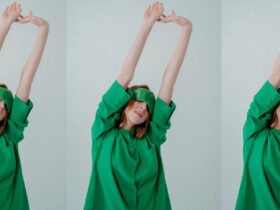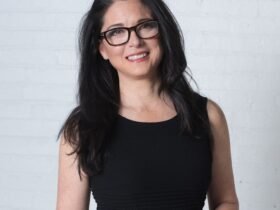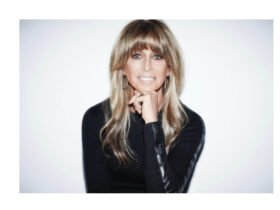When trade gets tough, women pay the price. Here’s how one expert says the “pink tax” is impacting female consumers.
You can tell a lot about a culture by what its women are whispering about at lunch. Lately, it’s not just mascara or must-haves—it’s margins. It’s money. It’s shipping delays, price hikes, and why their serum now costs 30% more. It’s whether their hair extensions are stuck in customs—or worse, they’re priced out of them altogether due to the newly imposed triple-digit tariffs.
In group chats, over coffee, and in Instagram stories, women aren’t just sharing what they’re buying—they’re dissecting how, when, and why. The tea is getting spilled, all right—but these days, the “T” unfortunately stands for tariff. Mom jokes aside, economic strategy has infiltrated the everyday vernacular and is now embedded in what used to be dismissed as “girl talk.”
Girl Math Redefined: Are Women Becoming Accidental Trade Analysts?
Women influence up to 85% of consumer spending in the U.S.—a number that adds up fast when you consider the nearly $35 trillion in global purchasing power that women control or affect. So when tariffs hit, it’s not just policy—it’s personal. The seismic trade shifts of 2025—145% duties on Chinese imports, the end of the de minimis loophole, and rising costs from Mexico and Canada—have reshaped what shows up in our carts and our closets.
The result is a generation of shoppers who suddenly sound like op-ed pundits and supply chain analysts. TikTok influencers are breaking down tariff codes. Instagram reels explain what bonded warehouses are. Brands are referencing tariffs in irreverent window displays. Even bar chalkboards are riffing on them to get people in the door. Think: “No Duty on Happy Hour” or “Tariffs Got You Down? Our Beer Won’t.”
This is the first time since the 1930s that trade policy has so deeply infiltrated everyday consumer consciousness, and women are driving that awareness forward, not simply reacting to it. It boils down to three key trends defining the mindset shift of female consumers.
1: MINDFUL SPENDING BEATS MINDLESS SPLURGING
The fast fashion free-for-all is waning. Not just because of tariffs, but because value equations are being rewritten in real time. Women under 40 are reporting fewer purchases, but a higher spend per item. This mirrors a broader shift among Millennials and Gen Z, who increasingly prioritize quality over quantity, opting for fewer, better pieces that reflect sustainability, ethics, and long-term value. Resale platforms like ThredUp and The RealReal are booming. So are capsule wardrobes, resale Instagram accounts, and closet remix tutorials.
Impulse buying hasn’t disappeared yet; it’s being redefined. Online shopping has made it easier to research and invest, not just scroll and splurge. Women aged 35–44 currently spend $1,007 annually on clothing. Women aged 55–64 spend even more: $1,220. The new flex will likely not be how many pieces you snagged for $100, but how many years you can wear the same piece, styled a dozen different ways.
We’re seeing this shift modeled at the highest levels of visibility too: fashion icons like Kate Middleton, Michelle Obama, Sarah Jessica Parker, Billie Eilish, and Cate Blanchett are deliberately rewearing already-publicized looks with pride, effectively giving permission to the everyday woman to shop their closet over constant newness.
2: THE RETURN OF COMMUNITY COMMERCE
Women are reviving the sharing economy but in a more modern, tech-enabled way. Clothing swaps, neighborhood buying collectives, and even wig lending libraries are becoming more common. Peer-to-peer fashion platforms are seeing unprecedented female user growth. So is shopping small and local, especially when it fosters real and consistent connection and trust.
Women have long prioritized relationships—whether with people or with brands that feel personal, consistent, and aligned with their values. In today’s peer-powered economy, that loyalty often extends to stylists, resale curators, and trusted micro-networks.
Loyalty skews relational: women stick with people, yes, but also with brands that earn their trust. They’re more responsive to personalized loyalty programs, especially ones that offer private, not public, rewards.
3: PINK TARIFFS = FINANCIAL MICRO-AGGRESSIONS (LET’S CALL IT WHAT IT IS)
Even the terminology—”pink tariffs”—is troubling, reductive, and evokes the 1950s gender stereotypes where women are relegated to cinched and properly powdered, pastel boxes of femininity. It manages to both trivialize and normalize systemic economic discrimination.
As Susan Scafidi, director of Fordham’s Fashion Law Institute, aptly describes them in a recent Guardian article, these tariffs represent “financial micro-aggressions” embedded in our trade policy.
Let’s look at the cold, hard numbers: Women’s clothing faces tariff rates averaging 16.7%—nearly 3 percentage points higher than the 13.6% average for men’s items, according to the Progressive Policy Institute’s analysis of over 700 clothing tariff lines. Women’s silk underwear is taxed at 2.1%, while men’s silk briefs face only a 0.9% tariff, as reported by The Guardian. A woman’s wool overcoat? Taxed at 64.4 cents per kilogram plus an additional 18.8%. A comparable men’s coat? Just 38.6 cents per kilogram plus 10%, according to research published by Oxford University.
This disparity costs American women an estimated $2.5-2.77 billion annually in additional tariff burden—a financial penalty for simply purchasing clothes designed for their bodies. Now, with Trump’s tariffs driving effective rates to their highest levels since 1872, according to Yale Budget Lab, these existing gender disparities will only worsen. The categories facing the steepest hikes—lightweight clothing, wigs and hair extensions (most of which are imported from Asia), cosmetics, and feminine hygiene products—aren’t gender-neutral. They disproportionately affect women.
From April 24-25 alone, price spikes on gender-coded essentials were dramatic. Everyday beauty items saw steep increases. Wax strips and post-wax wipes tripled. Even thick kitchen cleaning towels soared 377%, from $1.28 to $6.10. Items associated with feminine self-care and home upkeep are now carrying hikes of 150% to nearly 400%.
THE PINK TAX BURDEN ISN’T EQUAL
It’s also important to note that this burden isn’t distributed equally among women, either. For women of color (who already earn less than white women for every dollar a white man makes), low-income women (who spend a higher percentage of their income on consumer goods), transgender women (who rely on gender-affirming products), and women battling cancer or autoimmune conditions (who depend on wigs and specialized cosmetics)—these aren’t luxury purchases. They’re essentials. They’re dignity. They’re identity.
As economist Ed Gresser pointed out in an interview with Forbes, “Single-parent families, which are 90% women-headed, spend about 40% of their income buying goods,” compared to just 20% for high-income households. Recently implemented tariffs are effectively “shifting tax burden away from the top end and toward the bottom end of earners, and it will fall most heavily on single moms.”
Dignity shouldn’t come with a 145% duty attached—yet here we are, with an economic policy that systematically penalizes femininity, treats women’s necessities as luxuries, and further entrenches economic inequality along gender lines.
MORE ON HERMONEY:
JOIN THE CLUB: Own your money, own your life. Subscribe to HerMoney today for inspiration, advice, insights and more!



















Leave a Reply